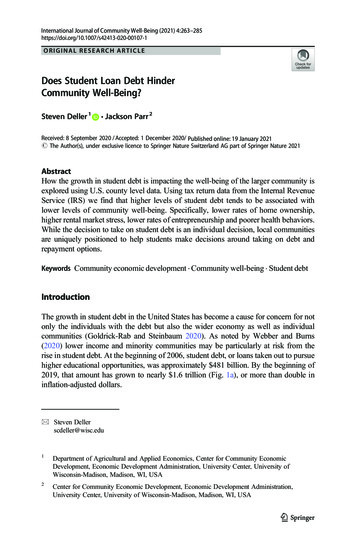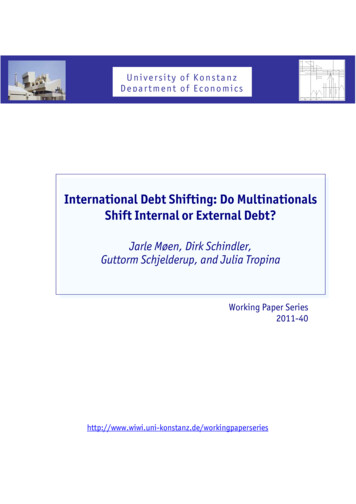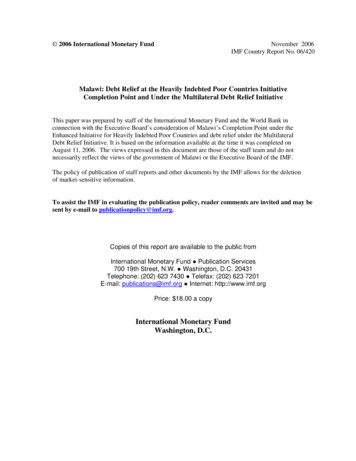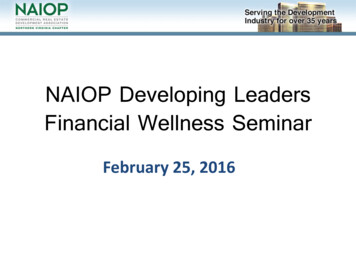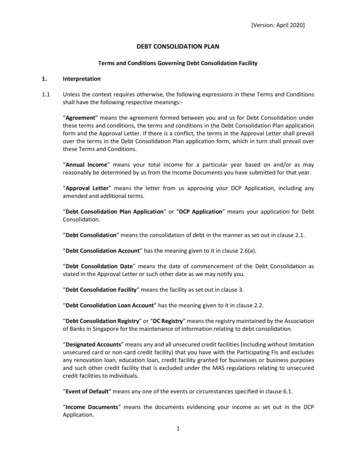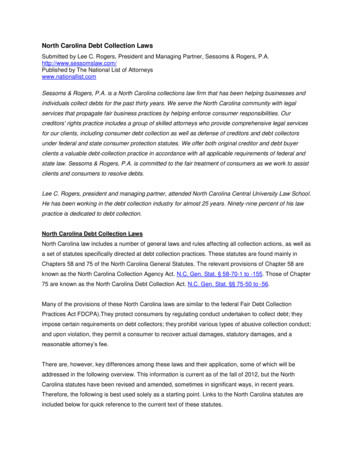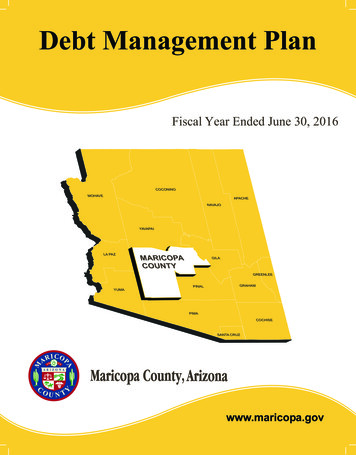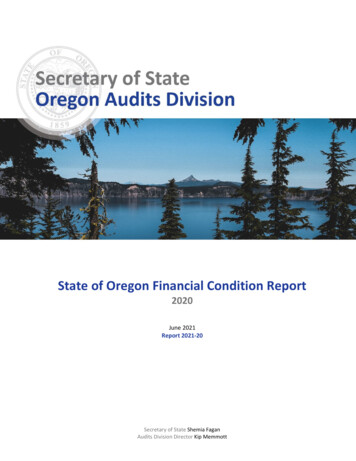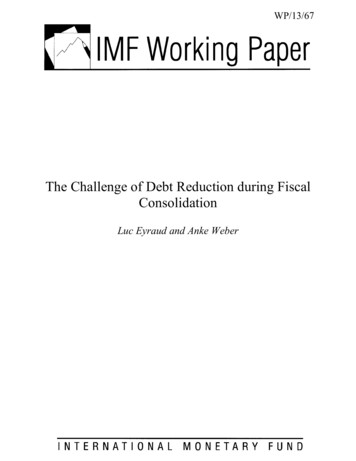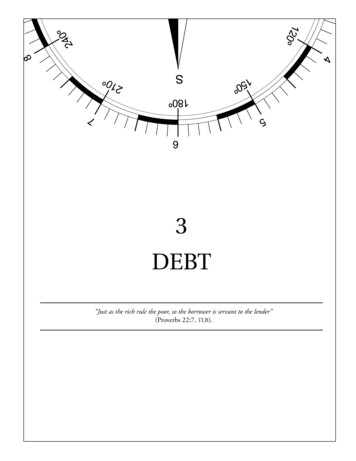
Transcription
Lesson 12Take Control of Debt—Term LoansLesson DescriptionThis lesson examines the features of a loan with a fixed period of repayment (term loan). Using an interactive definition, students focus on the facets of a term loan that differentiate it from other types of credit.Students then discuss the loans associated with a few purchases that are often term in nature. Studentscompare the costs and benefits of changing the loan term and interest rates when making a financingdecision. Outside of class, students research the terms of an auto loan and compute financing costs andpayment amounts using online resources.National Standards in K–12 Personal Finance Education (www.jumpstart.org)Credit and DebtStandard 1: Identify the costs and benefits of various types of credit.Instructional ObjectivesStudents will:ɃɃ Define term loans.ɃɃ Distinguish between annual percentage rate (APR) and finance charges.ɃɃ Analyze the effect of differing APR and loan length on monthly payment and total finance charges.ɃɃ Identify ways to reduce overall finance charges.Time RequiredOne 50-minute class periodMaterials RequiredɃɃ SmartBoard (optional) If using a computer and projector, please click when procedure says touch.ɃɃ Interactive PDF fileɃɃ Handout 1: Comparing Credit Offers for Term LoansɃɃ Handout 2: The Cost of CreditɃɃ Handout 3: Loan ResearchWarningThe first time you teach the lesson, save a master copy to your computer or a flash drive. If you do not, youwill not be able to save notes from each class. Before each class, reload the master copy of the notebookfile to be certain that all of the elements on each page are ready for use.Procedure11.Display Slide 1. Tell students that today’s topic is term loans.2.Display Slide 2. Display the instructional objectives for the lesson.3.Display Slide 3. Use the interactive on the slide and the information below to define term loans andthe highlighted features.Building Wealth—Lesson 12Federal Reserve Bank of Dallas
Touch “predetermined amount” to display information about how money is loaned with term loans.i. The amount of a term loan is determined up front.ii. Borrowers generally do not have the ability to borrow more than the predetermined amountwithout applying and qualifying for a new loan. Touch “specified payments at regular intervals” to display information about the repayment of termloans.i. Payments associated with term loans are set by the interest rate and terms of the loan.ii. The payment schedule is typically set in advance, and the date of repayment is known. Touch “finance charges” to display information about the cost of term loans.i. A finance charge is the cost of the interest, fees, service charges and any loan insurance coststhat a borrower will incur.ii. These fees must be presented to borrowers in advance of the loan as part of the disclosureagreement.4.Display Slide 4. Use the images on the slide and the information below to discuss a few common termloans. Point to the car.i. Explain that when a person does not pay cash for a car, he or she must finance the purchase.ii. The average length of a car note in 2011 was five years and two months.iii. The money often comes from a bank or the finance company associated with the dealership. Point to the house.i. Explain that most people cannot afford to pay cash for a house, so they take out a mortgage.ii. Mortgages typically take between 15 and 30 years to pay off.iii. Mortgages can be applied for at a bank or mortgage company. Point to the books and mortar board.i. Tell students that many people take out loans to pay for college.ii. Most loans are direct student loans funded through the federal government.iii. Student loans have long repayments, often as long as 20 years.5.Display Slide 5. Give each student a copy of Handout 1: Comparing Credit Offers for Term Loans tokeep as a reference. Use the information on the slide and below to distinguish between finance chargesand APR. Ask students to read the definitions on the handout or the slide and discuss the differences betweenthe two.Use the questions below to assess understanding of the concepts.i. Which one, finance charge or APR, is quoted as a dollar amount? Finance charge.ii. Is a higher interest rate always more expensive than a lower rate? No, if a loan has a longer term,it may have higher finance charges than a shorter loan with a higher interest rate.6.2What costs make up a finance charge? Interest costs, service charges and credit-related insurancecharges.Building Wealth—Lesson 12Federal Reserve Bank of Dallas
7.Display Slide 6. Use the table on the slide to discuss how APR affects the cost of a loan in terms of afinance charge. Tell students that this borrower is comparing five-year loans. Ask students to explainthe relationship between the interest rate and the total interest paid when the loan term is the same.Display Slide 7: The finance charges rise when the interest rate rises if the loan term stays the same.8.Display Slide 8. Use the table on the screen and the information below to discuss how length of theloan term affects the monthly payment. Ask students to explain the relationship among the monthlypayment, the loan term and the total interest paid.Display Slide 9: The longer the term, the lower the monthly payment, but higher the total interestpaid.Ask students when it might be better to take a shorter term with higher payments. When a person’sbudget allows them to pay the higher monthly cost and minimize the finance charges.Ask students when it might be better to take a longer term with lower payments. When a person’s budget will not allow them to bear a higher monthly cost, a person may still be able to make the purchaseby lengthening the term of the loan.Divide students into groups of two and give each student a copy of Handout 2: The Cost of Credit.Give students time to calculate the total cost and monthly payment of each loan.9.Display Slide 10. Go over the correct answers.Closure1.What are the two costs used to compare credit offers?Finance charges are the total dollar amount you pay to use credit. The charges include interest costs and othercosts, such as service charges and some credit-related insurance premiums. APR is the percentage cost ofcredit on a yearly basis.Both can be used to compare offer s and must be supplied in the disclosure agreements that accompany aloan.2.What is the relationship between interest rate and finance charges for loans of the same length?When the interest rate is higher, the finance charges of the loan rise.Assessment1.3Give each student a copy of Handout 3: Loan Research to be completed out of class.Building Wealth—Lesson 12Federal Reserve Bank of Dallas
Handout 1: Comparing Credit Offers for Term LoansTruth in Lending laws and regulations require all creditors to state, in writing andbefore the borrower signs any agreement, the cost of credit in terms of the financecharge and the Annual Percentage Rate (APR).To compare credit offers, consider these two items: Finance charge—the total dollar amount you pay to usecredit. It includes interest costs and other costs, suchas service charges and some credit-related insurancepremiums. APR—the percentage cost of credit on a yearly basis.The APR is the key to comparing costs, regardless of theamount of credit or how long you have to repay it.Federal law does not set interest rates or other credit charges,but it does require their disclosure so that you can comparecredit costs.4Building Wealth—Lesson 12Federal Reserve Bank of Dallas
NameDateHandout 2: The Cost of CreditSuppose you wanted to buy a new car. You have saved some money for a down payment, but you would like tofinance 15,000. Consider the three loan offers below. To find the monthly payment, add the stated finance chargesto the loan amount ( 15,000) and divide by the number of payments.Pixley Bank and Trust5.9% APR for 36 monthsTotal finance charges are 1,403.39.What is the total cost of the car loan (principal finance charges)?What is the monthly payment (total cost number of payments)?XYZ Savings and Loan7.5% APR for 48 monthsTotal finance charges are 2,408.81.What is the total cost of the car loan (principal finance charges)?What is the monthly payment (total cost number of payments)?Joe’s Auto Sales7.5% APR for 72 monthsTotal finance charges are 3,673.32.What is the total cost of the car loan (principal finance charges)?What is the monthly payment (total cost number of payments)?Now think about buying a house. After the down payment, you would like to finance 125,000.Compare the two offers below.Mary’s Mortgage Company15-year loan with 6% APR (180 monthly payments) Total finance charges are 64,867.79.What is the total cost of the mortgage (principal finance charges)?What is the monthly payment (total cost number of payments)?Fred’s Finance Company30-year loan with 6.5% APR (360 monthly payments) Total finance charges are 159,430.61.What is the total cost of the mortgage (principal finance charges)?What is the monthly payment (total cost number of payments)?5Building Wealth—Lesson 12Federal Reserve Bank of Dallas
NameDateHandout 3: Loan ResearchComplete the following table using information from a commercial bank’s website. Search for rates for a new car.Assume that you would like to finance 20,000. Find information for loans with terms of 36, 48, 60 and 72 months.Print and attach the online rate quote. Use the loan calculator at www.dallasfed.org/ educate/calculators/closedcalc.cfm to compute the finance charges.Name of bank or credit union:Website:Amount financed36 months 20,00048 months 20,00060 months 20,00072 months 20,000Annual percentage rate (APR)Monthly paymentTotal finance chargesTotal cost of the car (financecharges 20,000)61.What is the difference between an APR and finance charges?2.What happens to the total finance charges as a loan term lengthens?3.What happens to the monthly payment as a loan term lengthens?4.What is the effect of a higher APR on total finance charges?5.What is the effect of a higher APR on monthly payment?6.What two factors can a borrower consider to minimize the cost of credit?Building Wealth—Lesson 12Federal Reserve Bank of Dallas
the relationship between the interest rate and the total interest paid when the loan term is the same. Display Slide 7: The finance charges rise when the interest rate rises if the loan term stays the same. 8. Display Slide 8. Use the table on the screen and the information below to discuss how length of the loan term affects the monthly payment.
